Can You Cut Porcelain Tiles with an Angle Grinder? Tips and Tricks That Work!

Porcelain tiles are a beautiful addition to any home renovation project, but cutting them can be a bit of a challenge. If you’re wondering how to cut porcelain tiles with an angle grinder, you’re in the right place. We’ve got everything you need to know about using an angle grinder to cut porcelain tiles and make your project a success.
An angle grinder is an incredibly versatile tool that can be used for a wide variety of cutting, grinding, and polishing tasks. When it comes to cutting porcelain tiles, an angle grinder can be an effective option that gives you precise control over your cuts and allows you to get the job done quickly. But using an angle grinder to cut porcelain tiles requires a bit of skill and knowledge.
You need to choose the right blade for the job, set up your workspace properly, and take the necessary safety precautions to avoid injury. In this guide, we’ll walk you through everything you need to know about cutting porcelain tiles with an angle grinder. From choosing the right blade to making your cuts, we’ve got all the tips and tricks you need to ensure your project is a success.
So, let’s dive in and get started!
What is an Angle Grinder?
If you’re wondering whether you can cut porcelain tiles with an angle grinder, the answer is yes! An angle grinder is a versatile power tool that can cut, grind, and polish various materials, including tiles. When using an angle grinder to cut porcelain tiles, it’s essential to use a diamond-tipped blade to ensure a clean and precise cut. You should also take the necessary safety precautions, such as wearing eye protection and gloves.
Using an angle grinder can be quite loud and generate an ample amount of dust, so it’s advisable to work in a well-ventilated or outdoor area. With its adjustable guard, an angle grinder provides excellent control and maneuverability, making it an ideal tool for cutting tiles to fit around corners or irregular shapes. So, whether you’re a DIY enthusiast or a professional, an angle grinder is a must-have tool for any tile cutting job, including porcelain tiles.
Description of an Angle Grinder
An angle grinder is a versatile tool used for various applications, from cutting and grinding to sanding and polishing. It consists of a motor that rotates a disc or a wheel, which can be changed depending on the desired function. The motor is powered by electricity, compressed air, or gasoline, depending on the type of grinder.
Angle grinders can be either corded or cordless, with the latter being more portable and convenient. The disc and the guard are the essential components of an angle grinder, which helps protect the user from debris and sparks. The blade guard also assists in controlling the depth of cut and provides stability while working.
Angle grinders can be used on a wide range of materials such as concrete, metal, and wood. They are most commonly used in construction, metalworking, welding, and automotive repair industries. Overall, an angle grinder is a robust and versatile tool that can help you accomplish various tasks with ease and precision.

Can You Cut Porcelain Tiles with an Angle Grinder?
If you’re wondering whether or not you can cut porcelain tiles with an angle grinder, the answer is yes, you can! However, it’s not the easiest task in the world, and it does come with its own set of challenges. First and foremost, it’s important to note that not all angle grinders are created equal, and you’ll need to make sure that you have the right blade for the job. A diamond blade is recommended for cutting through porcelain tiles, as it’s strong enough to handle the dense material without cracking or breaking it.
It’s also important to wear protective gear like gloves, goggles, and a face mask, as the process of cutting porcelain tiles can create a lot of dust and debris. With the right tools and precautions, cutting porcelain tiles with an angle grinder can be done successfully and efficiently.
Factors to Consider Before Cutting Porcelain Tiles with an Angle Grinder
If you’re planning to cut porcelain tiles with an angle grinder, there are some important factors you need to consider before starting. First and foremost, you need to make sure you have the right type of blade for the job. A diamond blade is recommended for cutting porcelain tiles as it can handle the hard and dense material without chipping or cracking.
Secondly, you need to ensure that your angle grinder is powerful enough to make the necessary cuts. A grinder with at least 7 amps of power is recommended. It’s also important to take safety precautions before using the angle grinder such as wearing protective gear and using clamps to secure the tiles in place.
Lastly, practicing on scrap tiles before starting on your actual project is highly recommended to ensure you get the hang of it. With the right blade, angle grinder, and safety precautions in place, cutting porcelain tiles with an angle grinder can be a feasible and cost-effective option.
Tips for Cutting Porcelain Tiles with an Angle Grinder
If you need to cut porcelain tiles, an angle grinder can be a useful tool, but it requires some skill and know-how. Luckily, with the right blade and technique, you can make precise cuts and get the job done. First things first, make sure you have a diamond blade rated for porcelain.
Using a regular grinding wheel or blade can lead to chipping, cracking, or even shattering the tile. Once you have the correct blade, set the depth of the cut and make sure the tile is secure. Next, cut slowly and steadily, making sure to keep the blade perpendicular to the surface of the tile.
You may need to make multiple passes, so take your time and be patient. Don’t force the blade, as this could lead to overheating or damage to the tile. With careful attention and practice, cutting porcelain tiles with an angle grinder can be a breeze.
Which Blade to Use for Cutting Porcelain Tiles?
Yes, you can cut porcelain tiles with an angle grinder. However, it is crucial to select the right blade for the job. Porcelain is a dense and hard material, so you need a blade that can handle the pressure without breaking or chipping the tiles.
The ideal blade for cutting porcelain tiles is a diamond blade. It has abrasive surfaces made of tiny diamond particles that can cut through the porcelain with ease. There are two types of diamond blades that you can use: continuous rim and turbo rim.
The continuous rim blade has a smooth edge that is perfect for making accurate cuts, while the turbo rim blade has serrated edges that can grind through the tile faster but may leave rough edges. It is essential to choose the right blade for the task at hand to achieve a clean and precise cut on your porcelain tiles.
Different Types of Blades for Porcelain Tiles
When it comes to cutting porcelain tiles, it’s crucial to use the right type of blade. Different types of blades are available in the market, each designed for a specific purpose. The two most common types of blades for porcelain tiles are continuous rim blades and turbo rim blades.
Continuous rim blades have a smooth, continuous edge, making them ideal for precise cuts. Turbo rim blades have a serrated edge, which quickly removes material, making them perfect for rough cuts. It’s important to remember that not all blades are suitable for all types of porcelain tiles.
Harder tiles require blades with extra diamond content to make the cut. So, which blade to use for cutting porcelain tiles? It comes down to the tile’s hardness, the desired finish, and the tool you’re using. Always consult a professional to ensure you’re using the correct equipment and techniques to keep yourself safe while achieving a clean, precise cut.
Description of the Best Blade for Porcelain Tiles
If you’re planning on installing porcelain tiles, it’s essential to use the right type of blade for cutting them. The best blade you can use for these types of tiles is a diamond blade. Diamond blades are specifically designed for high-speed sawing of hard materials like porcelain tiles, and they have special diamond crystals embedded in the blade that provide superior cutting performance.
This type of blade features a continuous rim or segmented rim that offers excellent precision and clean cuts without chipping or cracking the tiles. One thing to keep in mind, however, is that not all diamond blades are created alike. You need to choose a diamond blade that is designed specifically for porcelain tiles and that matches the specifications of your saw.
So before cutting your tiles, make sure you have the right blade for the job to ensure a smooth and efficient cutting process.
Safety Precautions When Cutting Porcelain Tiles with an Angle Grinder
Yes, you can cut porcelain tiles with an angle grinder. However, safety should always be your top priority when working with power tools, especially when cutting hard materials like porcelain tiles. To ensure your own safety and the successful completion your project, there are several precautions you should take.
Firstly, wear protective gear like safety glasses, a dust mask, gloves, and earplugs. Secondly, use a diamond blade made specifically for cutting porcelain tiles and ensure the blade is securely attached to the grinder. Thirdly, keep the tiles secured and make sure they are not at risk of slipping or moving during the cutting process.
Finally, use a steady hand and take your time to make precise cuts. By following these simple safety precautions, you can easily and safely cut porcelain tiles with an angle grinder.
Protective Gear
When it comes to cutting porcelain tiles with an angle grinder, safety should always be the top priority. To ensure that you are protected from any possible accidents, it is essential to wear the appropriate protective gear. The first thing you would want to do is wear safety goggles or a visor to protect your eyes from any debris that might fly up during the cutting process.
Wearing a dust mask is also important to prevent you from inhaling any harmful debris that may cause respiratory problems. Additionally, you want to make sure you wear work gloves to protect your hands from any sharp edges or cuts. Finally, sturdy work boots with steel toes are vital to protect your feet in the event of a slip or fall.
Remember, your safety is paramount when working with an angle grinder, so always wear protective gear to prevent injuries.
Working Environment
When cutting porcelain tiles with an angle grinder, safety should always be your top priority. First and foremost, make sure you are wearing the appropriate safety gear, including eye protection and gloves. Additionally, ensure that the area around you is clear of any obstacles or potential hazards that could cause accidents.
It’s also important to keep the angle grinder’s disc guard in place and properly adjusted to prevent any unintentional contact with the blade. In addition to safety gear, it’s important to consider the potential airborne dust and debris that may be generated during the cutting process. This can be harmful to your respiratory system, so it’s recommended to wear a dust mask or respirator to protect yourself.
You should also position a fan or ventilation system to draw any dust away from your face and lungs while cutting. Lastly, it’s important to be mindful of the angle grinder’s burstiness and how you can minimize it while cutting porcelain tiles. Burstiness can cause rapid, unexpected movements of the angle grinder and lead to potential injury or damage to the tiles.
One way to minimize burstiness is to use a diamond blade specifically designed for cutting porcelain tiles. Additionally, make sure to apply even pressure to the angle grinder and avoid twisting or jerking movements. Overall, taking the necessary safety precautions and being aware of burstiness when cutting porcelain tiles with an angle grinder can help ensure a successful and injury-free experience.
By following these tips and utilizing the proper tools and safety gear, you can achieve precise and efficient cuts while also protecting yourself from potential harm.
Conclusion
In conclusion, the answer to the million-dollar question, “Can you cut porcelain tiles with an angle grinder?” is a resounding yes! However, this task requires some patience, skill, and a dose of creativity. Think about it as an intricate dance between the porcelain tile, the angle grinder, and your steady hands. With the right tools and techniques, you can turn a seemingly impossible project into a masterpiece that will add value and elegance to your home.
So go ahead, grab your angle grinder, and let your inner craftsman shine!”
FAQs
What is an angle grinder and how does it work?
An angle grinder is a handheld power tool used for cutting, grinding, and polishing. It works by rotating a disc or wheel at high speeds.
Are porcelain tiles harder to cut than other types of tiles?
Yes, porcelain tiles are harder to cut compared to ceramic or natural stone tiles because of their density and hardness.
Can an angle grinder be used to cut porcelain tiles?
Yes, an angle grinder with a diamond cutting disc can be used to cut porcelain tiles. However, caution must be taken to avoid chipping, cracking or damaging the tiles.
What type of blade or disc is best for cutting porcelain tiles with an angle grinder?
A diamond cutting disc is the best type of blade for cutting porcelain tiles with an angle grinder.
How do I prevent chipping or cracking when cutting porcelain tiles with an angle grinder?
To prevent chipping or cracking, mark the cutting line on the tile, use a guide to keep the angle grinder aligned, and cut slowly and steadily without applying too much pressure.
What safety measures should I take when cutting porcelain tiles with an angle grinder?
Wear protective gear, including safety glasses, ear protection, and a dust mask. Keep the work area clean and free of debris, and always unplug the angle grinder when changing blades or discs.
Can I use an angle grinder to shape or polish the edges of porcelain tiles?
Yes, an angle grinder with a diamond polishing pad or grinding wheel can be used to shape or polish the edges of porcelain tiles for a smooth finish.




